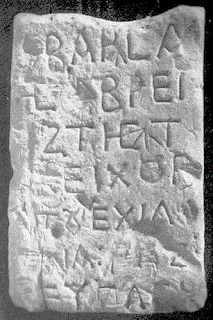The name is derived from the Bulgars, a semi-nomadic people in Eastern Europe during the Middle Ages. A tribal union of Bulgar tribes established the Bulgar state, known as Old Great Bulgaria in the mid-7th century, eventually giving rise to the Danube Bulgaria by the 680s and Volga Bulgaria. The language is extinct in both Danube Bulgaria (10th century) and Volga Bulgaria (16th century)[1].
One of the earliest written sources which mentioned Bulgars is the Chronography of 354 AD. Bulgars came to Europe together with the Huns[2] and both groups of people didn't have written languages. Apparently Bulgars played an important role in the Hunnic union - we are told that Bulgar tribes were active in the North-Western Carpathians at the beginning of 5th century against the Germanic Lombards. There were two battles and the Bulgars were victorious. In the first battle the Lombard king Agelmund was killed. His son Laimicho attempted to revenge his father but was defeated and forced to run away.[3] After the battle of Nedao (455 AD.) in which Attila's sons were defeated, the Huns and Bulgars, as we learn from Jordanes, retreated into their "inner" territory on the river Dnieper (Ukraine) where they reorganized on a smaller scale.[4]
According to Pritsak the Hunnic language was between Turkic and Mongolian, probably closer to Turkic.
According to Antoaneta Granberg (University of Gothenburg) the Hunno-Bulgarian language was formed on the North-Western borders of China in the 3rd-5th c. BC. Analyzing the loan-words in Slavonic, she concluded that Bulgar language was directly influenced by various languages: Turkic, Mongolian, Chinese and Iranian. In the 6th century when Turkic tribes reached the borders of the China, the Huns and Bulgars were not there.[6] Turkic languages contain Hunno-Bulgarian loans but they were taken via Chinese mediator. For example Hunnic ch’eng-li (sky, heaven) was borrowed from Chinese as tängri in Turkic.[7] The Hunno-Bulgarian language has non-Turkic and non-Altaic features. Granberg observes that "Altaic has no initial consonant clusters, while Hunno-Bulgarian does. Unlike Turkic and Mongolian, Hunno-Bulgarian language has no initial dental or velar spirants. Unlike Turkic, it has initial voiced b-: bagatur (a title), boyla (a title). Unlike Turkic, Hunno-Bulgarian has initial n-, which is also encountered in Mongolian: Negun, Nebul (proper names)." In sum, Antoaneta Granberg concludes that "Hunno-Bulgarian language has no consistent set of features that unite it with either Turkic or Mongolian. Neither can it be related to Sino-Tibetian languages, because it obviously has no monosyllabic word structure." Often Hunno-Bulgarian language is termed Turkic which is not correct, Altaic is more to the point.[8]
Some scholars claim that Bulgars were specific Turkic tribes, the so called Oghurs, and that they spoke Oghur Turkic. However this hypothesis cannot explain the genetic tests. Also such people as Oghurs are not documented in any of the Chinese, Iranian, Indian or Armenian sources. Actually we know nothing of the languages of the nomadic people who entered Europe before the 7th century AD. The theories for existence of specific Turkic group (the so called Oghurs), to which Bulgars supposedly belonged, are nothing more than a hypothesis.[2]
Affiliation of the Bulgar language
 |
| Hunno-bulgarian written in Greek alphabet Inscription on stone from Dluzho, north-eastern Bulgaria, 8th century |
The Huns and Bulgars spoke closely related languages different from others “barbarian” languages. The relations between the language of Bulgars and Huns were studied by Harvard professor Pritsak in his notable work "The Hunnic Language of the Attila Clan" (1982).[5] He termed the language of Bulgars as Hunno-Bulgarian. Pritsak analyzed the 33 survived Hunnic personal names and concluded that the language of the Bulgars was Hunnic language:
1. Danube-Bulgarian was a Hunnic language (page 444)
2. Danube-Bulgarian had the suffix /mA/, with the same meaning as the Middle Turkic suffix /mAt/ 'the greatest among' (page 433)
3. In the Hunno-Bulgarian languages /r/ within a consonantic cluster tends to disappear (page 435)
4. In Hunno-Bulgarian there was also a tendency toward the develop ment of di > ti > ći (page 436)
5. In the Hunno-Bulgarian there was vocalic metathesis bli- < *bil (page 443)
6. There was initially a g- in the Hunno-Bulgarian languages (page 449)
7. One of the typical features of the Hunno-Bulgarian linguistic group is a cluster in the word initial position. (page 460)
8. Hunnic (language) shared rhotacism with Mongolian, Old Bulgarian, and Chuvash. (page 470)
1. Danube-Bulgarian was a Hunnic language (page 444)
2. Danube-Bulgarian had the suffix /mA/, with the same meaning as the Middle Turkic suffix /mAt/ 'the greatest among' (page 433)
3. In the Hunno-Bulgarian languages /r/ within a consonantic cluster tends to disappear (page 435)
4. In Hunno-Bulgarian there was also a tendency toward the develop ment of di > ti > ći (page 436)
5. In the Hunno-Bulgarian there was vocalic metathesis bli- < *bil (page 443)
6. There was initially a g- in the Hunno-Bulgarian languages (page 449)
7. One of the typical features of the Hunno-Bulgarian linguistic group is a cluster in the word initial position. (page 460)
8. Hunnic (language) shared rhotacism with Mongolian, Old Bulgarian, and Chuvash. (page 470)
Some scholars claim that Bulgars were specific Turkic tribes, the so called Oghurs, and that they spoke Oghur Turkic. However this hypothesis cannot explain the genetic tests. Also such people as Oghurs are not documented in any of the Chinese, Iranian, Indian or Armenian sources. Actually we know nothing of the languages of the nomadic people who entered Europe before the 7th century AD. The theories for existence of specific Turkic group (the so called Oghurs), to which Bulgars supposedly belonged, are nothing more than a hypothesis.[2]
References:
1. The Hunno-Bulgarian Language, Antoaneta Granberg, Göteborg University, 2008, page 7
Образуване на българската народност, Димитър Ангелов, p. 123
5. The Hunnic Language of the Attila Clan, OMELJAN PRITSAK, Harvard Ukrainian Studies (1982)
No comments:
Post a Comment